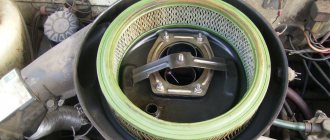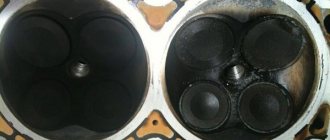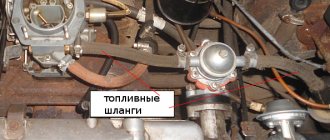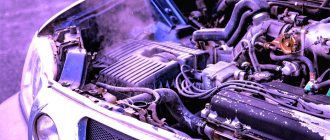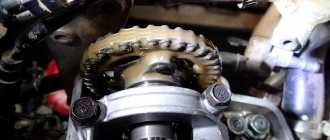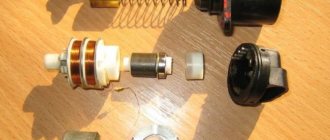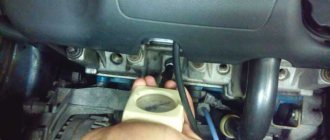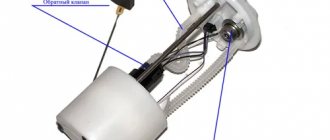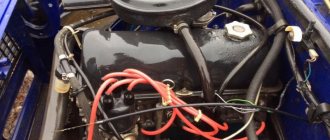The VAZ 2107 is not the best model among cars in its class when compared with foreign equivalents. However, thanks to its low price and accessible service, the car has been popular throughout the post-Soviet territory for many years. The car was produced from 1982 until 2014. That is, the oldest model is more than 30 years old. During such a period of operation, the owner will be able to encounter all types of faults and investigate most of the causes of problems.
After several years of operation, the VAZ 2107, as well as the almost identical model 2105, begins to show a new character with changes not for the better.
Malfunctions associated with the power unit and its body kit are of a different nature, but are symptomatic:
- the engine stalls periodically;
- does not maintain stable speed;
- unstable operation at idle;
- hard to start;
- insufficient power;
- increased fuel consumption.
All malfunctions appear for two reasons: violation of adjustments or wear of parts.
The engine does not idle: the main reason
The first thing you need to pay attention to is the solenoid valve. It is installed, however, not on all VAZ 2106 carburetors
It is this small device that most often falls into disrepair. Its operating principle is similar to a solenoid relay - there are windings, an armature, and a return spring, but the dimensions are somewhat smaller.
The function of the solenoid valve is to open the path for gasoline to flow (with the throttle valve closed) when the ignition is turned on. And close when disconnected, respectively.
The most common breakdowns of the solenoid valve, as a result of which the idle speed disappears:
- The winding is destroyed, the armature with the needle does not move, fuel is not supplied.
- The fuel nozzle located on the edge of the valve is clogged.
- The valve armature is jammed due to deformation.
You can check this device very quickly; you will need a small piece of wire, stripped from both edges. Connect one end to the positive side of the battery, and connect the other end to the terminal of the solenoid valve. There should be a fairly loud click, but if it doesn’t, then most likely the winding is damaged.
If there is a click, remove the wire connected earlier and turn on the ignition. Place the power connector onto the valve. If there is no click, then the wiring is damaged. In the event of a breakdown, there can be three exits, you can use any:
- If the solenoid valve is completely destroyed, it would be wise to unscrew it and remove the tip (fuel nozzle). And thus get to the nearest store without much difficulty. The price of a new VAZ 2106 solenoid valve is about 100 rubles, so repairs will not be expensive.
- Temporarily connect the output of the solenoid valve to the positive terminal of the battery - if the wiring is damaged. But in this case you will have to remove the wire during each stop.
- It would be much more efficient to run a wire from the solenoid valve output to the “+B” ignition coil contact. The fact is that voltage appears on it only after the ignition is turned on.
Why do carburetor cars start and stall?
If the car starts and stops immediately, the problem may be due to a lack of fuel in the float chamber. You can try manually pumping up the fuel pump. The work must be checked and replaced if necessary.
Before self-cleaning the fuel system in general and the carburetor in particular, you should remember that any unconscious manipulation can lead to a sharp increase in fuel consumption.
Another reason for engine stalling is a clogged strainer in the front carburetor. If the car starts and stops after a few seconds due to this filter, it needs to be cleaned and flushed. To do this, use a toothbrush and thinner (gasoline or acetone). After this, immediately clean the slot into which it is inserted together with the filter.
It happens that in VAZ cars, a few seconds after starting, the speed decreases due to a malfunction of the solenoid valve. The test is carried out as follows: the valve is unscrewed, power is supplied to the positive contact, the housing is closed to engine ground. If the valve is operating correctly, a distinct sound will be heard and the needle will enter the body.
You can simply connect the cable to the valve and push it into place. If you do not hear a click, the valve is faulty. We unscrew the valve and remove the jet from it. If it is bent, it needs to be replaced. Make sure the valve stopper needle moves freely and that the valve gasket is not torn and is tight against the body.
If there is valve clicking, the EPHC system needs to be diagnosed. The idle fuel jet may need to be cleaned. If the vehicle's engine speed decreases, the blockage can affect stability. To clean the nozzle, it is necessary to create a greater vacuum in the system channels.
To do this, start the car and increase the number of revolutions to 3000. Unscrew the injector holder (solenoid valve) several turns. This allows you to create the necessary vacuum in the channels. We repeat the procedure several times.
What to do
If you lack knowledge or lack confidence in your own abilities, you can seek help from a service station, where specialists will conduct a diagnostic examination and repair the car.
If the user decides to figure it out on his own, he must do the following.
When I press on the gas, the car jerks and does not move.
In the case when the car behaves predictably at idle, and when the trigger is pressed, jerks are felt, and the car slowly picks up speed. The problem lies in the lean or over-enriched mixture entering the cylinders. It doesn’t matter whether it’s an old VAZ or a new modification like the Hyundai Accent. The original source is located here.
The secondary question is how this happens, because in 50% of cases the carburetor or injector is configured correctly.
The car jerks when accelerating and pressing the gas sharply
Similar symptoms occur on fuel-injected foreign cars - when the trigger is pressed firmly, the car jerks. In this case, acceleration occurs in normal mode. For cars such as Ford Focus, Opel Astra J, Chevrolet Cruze, the problem may be a breakdown of the ECU, mass air flow sensor, or TPS. The problem also does not avoid modifications of the VAZ 2114 and Audi A6 C5.
When you press the gas pedal, the car stalls, then jerks sharply
When a vehicle stalls during acceleration, followed by a sharp jerk, and then the dynamics stabilize. The following items need to be checked:
- air line;
- accelerator pump;
- fuel quality;
- checkpoint;
- main fuel pump;
- ignition settings;
- MRV sensor.
Owners of the Lada Priora periodically face the problem of fuel pump failure. Here it will be enough to replace the element with a new one, to be on the safe side, clean the lines (low-quality fuel could get in).
Also, in some cases, the engine begins to stall and then accelerate. Here, the mass air flow sensor is checked, the spark plugs are diagnosed, the ignition angle is checked, and the injectors are clogged.
Additionally, if you have an automatic transmission, you need to check this mechanism. About 20% of visits to a car service center with similar faults end in “treating a surprise” inside the torque converter.
The car jerks when you press and release the gas
If, when the speed is reduced, the car begins to nod, and during acceleration it jerks again, there may be two sources of the problem.
- Sensor failure. Faulty sensors send incorrect data to the ECU, causing a disruption in the uninterrupted fuel supply.
- Clogged dosing elements (nozzles, jets). Owners of classic models such as the VAZ 2107 often encounter a similar problem. A clogged injector, after releasing the gas, “spits out” part of the fuel, which causes an increase in speed. During sudden acceleration, the element does not have time to supply the required amount of mixture to the cylinder.
Carburetor car jerks when you press the gas
If a problem is detected on carburetor vehicles such as VAZ 2109/2106
First of all, you need to pay attention to the fuel supply system. The design of standard Solex carburetors has outlet tubes designed to supply gasoline to the mixture formation chamber. By pouring low-grade fuel, thin channels can become clogged, which prevents its free passage
By pouring low-grade fuel, thin channels can become clogged, which prevents its free passage.
The defect is eliminated by purging the unit with compressed air and preliminary cleaning the jets (just in case).
It is also necessary to check the main pump (a problem with all classics), and the ignition timing.
When you press the gas, a car with an injection engine jerks
If the injection VAZ 2110 twitches, the search for the problem should start from the MVR, PDZ, and ECU sensors. In this case, faulty sensors can send a false signal to the control unit, which is the primary source of the trouble.
The last point is failure, ignition interruptions. Spark plugs and armored wires are diagnosed.
Diesel car jerks when pressing gas
It is moisture that oxidizes metal surfaces, which leads to jamming of the structure.
Failure repair is carried out by replacing the damaged part.
Starter malfunctions
The VAZ 2107 car is started using an electric starter. The main difficulties arise due to the following reasons:
- Low battery level.
- Solenoid relay failure.
- Overrunning clutch failure.
If the carburetor is working properly and the ignition system is configured correctly, then most often the car will not start due to a broken starter. First of all, the charge level is checked; if it is insufficient, we remove it from the car and recharge it. If necessary, the mechanism is dismantled for repair or replacement.
Practice shows that eliminating the above malfunctions on an engine that starts poorly or does not start at all allows you to achieve a good result. Experts recommend checking first the carburetor, which is prone to clogging, and other systems that ensure a reliable start.
#1 ncknm
- New
- 3 messages
- Car make: VAZ 2107
- From: Moscow
Hello everyone, I have a VAZ 2107 carburetor. In general, I will try to describe the problem in as much detail as possible, although there are more likely two of them, I hope that the second follows from one.
The first problem is that the car stalls if you put the gas to the floor and spin the engine more than 3-3.5 thousand rpm, but this happens every other time, that is, sometimes you can, for example, turn the first three gears up to 5 thousand and the car will continue to move without any problems, but Most of the time it stalls. At the same time, it holds idle speed well, floats a little, of course, but not at all critical. That is, if you drive calmly, the problem is not noticeable. I'll continue. After the car stalls, it starts immediately with half a kick and stalls again, and no matter how much you try to keep the engine in working condition, whether by chugging or playing with the gas, it stalls and stalls. BUT, you just have to wait literally 1-2 minutes - it starts up as if nothing had happened and you can drive on.
Well, the second problem, as I said, they are probably connected. If you drive, for example, along the highway and keep the gas pedal in one position for a long time, then when you release the gas, the car stops idling, the solution is still the same, stand for a couple of minutes, start up and drive off.
I read similar topics and I’ll say right away, just in case, I replaced the fuel pump with a new one, cleaned the carburetor, adjusted it, tried installing another one, adjusted the valves, changed the spark plugs, and in the end I changed the cylinder block, replaced all the consumables, but the problem remained.
In any case, write your thoughts about this)
#2 do it yourself
- Car make: VAZ
- From: Chelyabinsk
What kind of ignition does it cost?
#3 Samen
- Car make: VW Sharan
- From: Bryansk
For example, a clogged fuel line or drainage in the tank. Problems with fuel supply can be determined by placing a piece of transparent hose between the pump and the carburetor.
A faulty switch can throw out a similar trick.
#4 ncknm
- Car make: VAZ 2107
- From: Moscow
What kind of ignition does it cost?
For example, a clogged fuel line or drainage in the tank. Problems with fuel supply can be determined by placing a piece of transparent hose between the pump and the carburetor.
A faulty switch can throw out a similar trick.
It seems unlikely to me, because all these symptoms are only on the move, you can accelerate as much as you want and nothing will happen.
#5 Schulz 21043
- Car make: VAZ 21043 1994. Honda CR-V 2002.
- From: Moscow
Which carburetor is it, ozone or solex?
#6 111
- Car make: Kalina.
- From: RSFSR
Check the condition of the distributor - the wire from the Hall sensor to the connector, as well as the operation of the vacuum and centrifugal regulators, and the serviceability of the switch.
#7 Samen
- Car make: VW Sharan
- From: Bryansk
It seems unlikely to me, because all these symptoms are only on the move, you can accelerate as much as you want and nothing will happen.
Fuel supply faults
It is quite easy to find out that the car stalls while driving due to the engine being “choked” with the fuel mixture - during a long drive you will find that the signal of the sensor responsible for this function is constantly on.
Here the problem lies in low-quality fuel, which does not quickly “ignite” from the spark of the candles. It can also be caused by gasoline not meeting the requirements for the octane number specified in the vehicle specifications. If there are problems with fuel, the gas pedal will be pressed all the way, and the car will not begin to gain speed. In addition, the car will periodically stall when the clutch is engaged.
Another symptom indicating problems with fuel is the appearance of problems with the car after refueling. The problem is characterized by a rapid drop in engine power at full speed, as well as when constantly changing gears. The way out of the situation is to completely drain the bad fuel mixture, wash the engine and all the fuel system pipes.
- Dirt in the fuel filter;
- Problems with injector nozzles;
- Dirty throttle valves;
- Fuel pump power failure.
The main symptom of a malfunction of these parts is that there will be a gradual drop in the power of the car’s engine, after which the car will stall even after sharply pressing the gas pedal. If you do not release the clutch carefully when changing gears, this will also cause the engine to stall.
The contamination of the fuel filter and fuel pump can be judged by the unstable operation of the machine even during idling and during rapid braking (when the supply of the fuel mixture decreases). And if the performance of fuel filters can be easily established during an external inspection and eliminated by replacing them, then to detect other causes, you need a full-fledged computer diagnostics, which can only be carried out in a car service center.
Another reason for a stalled car associated with the operation of the fuel pump is boiling gasoline in the fuel pump. This happens mainly in hot weather when the car is moving slowly or standing on the highway in traffic jams. The car will start to stall while driving, but when you turn on the idle speed and press the clutch, it will start again.
If boiling occurs, it is better to stand in a traffic jam with the engine turned off and gradually cool the car. After 5-10 minutes, the car's operation will be stable again.
Poor quality fuel
In approximately 50% of cases, the “culprit” for loss of traction is fuel. Due to its poor quality or inappropriate octane number (OCN), the engine does not develop power.
You can determine that there is inappropriate fuel in a car tank based on a number of signs:
- The engine started getting worse.
- There was detonation. This symptom manifests itself most clearly if fuel with the required octane number is diluted with gasoline with a lower octane rating.
- When examining spark plugs removed from the cylinder block (BC), you can see black or reddish (brick) carbon deposits, which are uncharacteristic of serviceable parts, which indicates the presence of unnecessary impurities. The first option indicates that gasoline does not burn completely, the second confirms the presence of additives containing metal.
- Ineffective spark plugs. This can be determined during a sharp increase in speed, when the engine has no reserve for further acceleration. The spark plugs may be clogged due to low-quality fuel or may simply have exhausted their service life.
Adjusting the idle speed of the VAZ 2107 photo and video
The stable operation of the VAZ 2107 car engine depends on the serviceability and correct settings of its systems. Adjusting the idle speed is possible without the involvement of specialists, provided that all recommendations in the operating manual are followed. A serviceable carburetor with the correct ignition timing and gaps between the distributor contacts.
Adjustment of the mode according to the technical documentation must be carried out using a device that determines the level of CO in the exhaust gases. In garage conditions, the carburetor is usually adjusted by eye and using the built-in tachometer. The description prescribes a crankshaft speed ranging from 700 to 900 rpm. At lower values, the carburetor system is unable to ensure stable engine operation; at higher values, fuel consumption increases.
Engine system diagnostics
The power unit of the VAZ 2107 runs on gasoline; the quality and composition of the fuel does not always meet the standard requirements. A clogged carburetor, particularly the idle system, can cause erratic operation. Depending on the degree of contamination, manifestations may vary, up to and including spontaneous stopping of the engine.
The main reasons for the unstable operation of the VAZ 2107 car engine when idling:
- incorrect fuel level in the float chamber;
- clogging of the strainer, jets and channels;
- restriction or difficulty in valve travel in the EPH;
- air leakage through damaged gaskets, membranes or tubes;
- air filter clogged;
- burning of contacts or incorrect gap between them;
- substandard candles;
- Incorrect ignition timing adjustment.
Before you start adjusting the carburetor, you should restore its functionality, otherwise it is impossible to achieve a sustainable result.
Maintenance and Troubleshooting
Routine work on systems that ensure engine operation should begin with a complete inspection. For convenience, the air filter housing is removed from the carburetor and all air tubes are inspected. There should be no cracks on them, and the material should remain elastic. If necessary, the carburetor is dismantled and completely disassembled with defect detection and replacement of faulty parts.
The next stage involves diagnosing, eliminating identified faults and adjusting the ignition system. It is recommended to clean the contacts in the distributor with fine sandpaper, replace the spark plugs and set the timing correctly. This can be done using a tester or a primitive test lamp. It makes sense to proceed directly to regulating the VAZ 2107 engine only if the carburetor and other systems are in order.
Setting up the power unit
Adjustment of the idle speed is carried out indoors with good ventilation or outdoors. It is necessary to make sure that the air damper is completely open, for which the handle is pushed forward until it stops. Now the carburetor is completely ready for setting the mode.
The wizard's sequence of actions is as follows:
- A device sensor is inserted into the exhaust pipe, which determines the concentration of carbon monoxide in the exhaust. The device turns on, and readings are taken from it that characterize the operation of the carburetor.
- If the established parameters are exceeded, the mixture quality screw is tightened using a screwdriver. This action is performed in several stages with constant monitoring of the exhaust.
- The drop in idle speed is compensated by the fact that the VAZ 2107 carburetor is adjusted by the mixture amount screw.
The procedure continues until the engine operates stably in this mode. If the device is not available, adjustment of a working carburetor on a VAZ 2107 car can be done without it. With a certain skill, this operation will not take much time.
Adjusting the idle speed without a device
Most experienced craftsmen and drivers configure the VAZ 2107 power unit as follows:
- The carburetor mixture quality screw sets the minimum speed at which the engine runs unstable, but does not stall.
- The rotation speed increases by adding mixture.
The procedure with the mixture quality screw is repeated until the carburetor ensures stable engine operation.
In practice, this method is used quite often and, with sufficient driver experience, a positive result is guaranteed.
The engine only runs on choke, why?
Why does a warm engine only run on choke?
Because either the fuel mixture supplied to it is too lean, which does not allow it to develop the required power and, accordingly, maintain the idle speed within 600-800 rpm, or there is a violation of spark formation on the electrodes of the spark plugs, leading to incomplete or untimely combustion of the fuel mixture, which is so also affects its power performance.
The “choke” handle extended towards itself allows you to close (partially or completely) the carburetor air damper, which ensures forced enrichment of the fuel mixture by reducing the proportion of air in it and maintaining minimum idle speed.
The reasons for the engine running only on choke are related to the carburetor and the power system
Using the example of engine 21083 of VAZ 21083, 21093, 21099.
The carburetor idle system (IAC) does not work
The fuel mixture does not enter the engine when the vehicle is idling, either at all or only partially. Reasons: the CXX is completely clogged, the CXX fuel jet is clogged, the solenoid valve or the EPH system is not working, the correct position of the throttle valve of the 1st chamber or the carburetor air damper is not correct.
Read more about how to diagnose and troubleshoot the idle system of the Solex carburetor 2108, 21081, 21083: “The idle system of the Solex carburetor does not work.”
The fuel pump does not pump
The supply of gasoline to the carburetor is disrupted; the fuel mixture at the outlet is lean. Reasons: fuel system filters are clogged (in the fuel pump, fine fuel filter, filter on the fuel intake in the gas tank), the fuel pump valves are faulty, the fuel pump drive is not adjusted (the pusher is worn out).
Damaged engine power system
Fuel from the gas tank is supplied in incomplete quantities or not at all. Reasons: system filters are clogged, the fuel intake in the fuel tank is clogged, fuel lines are damaged (broken, deformed).
“Suction” of foreign air into the carburetor
Excess air entering the fuel mixture through leaky carburetor seals leans the fuel mixture. Possible places for excess air to “suck in” are the gasket under the carburetor, the rubber o-ring on the fuel mixture “quality” screw, the o-ring on the EMC.
How to deal with this malfunction and find the place of the “suction”: “Suction of foreign air into the carburetor.”
The reasons for the engine running only on choke are related to the ignition system
The ignition timing is incorrectly set
Ignition that is too early or, conversely, too late does not allow timely ignition of the fuel mixture in the combustion chambers. In this case, the resistance to rotation of the crankshaft increases to such an extent that the engine can start and operate only on “choke”, which makes it possible to somehow compensate for the loss of power by additionally enriching the fuel mixture.
Parts of the ignition system are “broken”
A short circuit in the elements of the high-voltage circuit of the ignition system (spark plugs, high-voltage wires, distributor cover) leads to a disruption in spark formation on the spark plug electrodes. The spark periodically disappears and its strength decreases. This does not allow the fuel mixture to be effectively burned and the engine to reach the required idle speed. Power losses can only be compensated by forced enrichment of the fuel mixture by pulling the “choke” handle towards you.
The timing belt jumped or was installed incorrectly during replacement (the position marks of the camshaft and crankshaft have shifted relative to each other).
The third stage is diagnostics of the VAZ-2105 ignition system
One of the models of traditional ignition systems can be installed in a VAZ-2105 car:
- classic contact (the simplest in its functions);
- electronic contactless (more complex option);
- combined.
But any of the above ignition systems has three components:
- Low voltage:
- breaker contacts;
- box with electronics for generating an ignition spark.
- Coil (also called a step-up transformer).
- High voltage:
- distributor (mechanical or electronic type);
- wires for transmitting high voltage current to the spark plugs;
- candles.
Experienced motorists advise starting diagnostics by checking the operation of the high-voltage part of the automobile ignition system.
Step one - check for the presence of a spark on the central wire, which serves to connect the distributor to the coil. For this:
- the tip of the high-voltage wire is removed from the distributor cover;
- the wire is brought to the part that is in contact with the ground of the vehicle;
- it is fixed with a gap of 5-7 mm (that is, the tip should not come into close contact with the part itself).
Step two - turn the engine using the starter and monitor the car’s reaction:
- there is a spark between the tip of the high-voltage wire (may be accompanied by a loud click);
- there is no spark.
The first option with a spark involves the following actions:
- Look for traces of electrical breakdown on the distributor cap.
- Check the wires and their tips (ideally they should be dry and clean).
- Check the spark plugs (they may need to be cleaned and dried).
- Inspect the entire ignition system for the presence of a spark.
If there is a spark when examining the ignition system, then everything is functioning normally. If there is no spark, it means that there is no voltage supplied to the ignition coil.
Step three - check the voltage supply to the ignition coil. The problem with its absence most often lies in:
- breakdown or short circuit;
- poor contact between the wires and the coil itself (for example, wet dirt got in).
Step four is to inspect the breaker contacts. They may have oxidized, so you just need to clean them with a file. After cleaning, the contacts are checked for voltage supply to the ignition coil. To do this, you need to tug them a little and watch the reaction of the light bulb. If the light is on, the cause of the problem has been found. If the light bulb shows no signs of life, then send the car to a car service center.
Maintenance and Troubleshooting
Routine work on systems that ensure engine operation should begin with a complete inspection. For convenience, the air filter housing is removed from the carburetor and all air tubes are inspected. There should be no cracks on them, and the material should remain elastic. If necessary, the carburetor is dismantled and completely disassembled with defect detection and replacement of faulty parts.
The next stage involves diagnosing, eliminating identified faults and adjusting the ignition system. It is recommended to clean the contacts in the distributor with fine sandpaper, replace the spark plugs and set the timing correctly. This can be done using a tester or a primitive test lamp. It makes sense to proceed directly to regulating the VAZ 2107 engine only if the carburetor and other systems are in order.
Checking the fuel pump
If you have disassembled important structural elements of the injector power system, then it is really worth checking again whether all the hoses and mechanisms have been reconnected correctly. See if the absorber is connected back correctly, or if one of the hoses may be forgotten. If everything is in order, we move on to the fuel pump.
Checking its condition is very simple: you need to insert the ignition key into the first position. If you can hear the pump running, it means it is working. In any other case, you should seriously think about its diagnosis and subsequent repair. And, I repeat once again, severely clogged filters prevent the normal amount of combustible mixture from entering the engine cylinders.
Starter maintenance
Another mandatory step in setting up the carburetor on the VAZ-2107 is servicing the starting device. This adjustable mechanism is necessary for proper fuel delivery and starting of a cold engine. As soon as the automation detects the low operating temperature of the power unit, a large amount of gasoline is supplied to the fuel-air mixture, which allows for a confident start of the engine and subsequent retention of the desired speed.
The standard frequency of the starting device is one and a half thousand revolutions per minute, which is equal to the idle mode of the engine. With higher or lower values, problems may arise in the operation of the power unit. The car starts poorly, fuel consumption increases significantly, and all technical fluids take a long time to reach their optimal temperature.
It may also be interesting: Polishing headlights is necessary when the headlights are cloudy
The principle of operation of the starting device is as follows:
- The cable is attached to a three-arm lever, which it cocks by turning counterclockwise.
- Simultaneously with the cable, a telescopic rod moves, which opens and closes the air channel flap.
- The other arm of the lever rests on the throttle valve axis, responsible for supplying fuel to the chamber.
- When the air damper is closed, the throttle chamber opens slightly, providing a rich air-fuel mixture.
If for some reason the starting device is not adjusted, problems arise with speeds that a cold car cannot maintain stably. An unenriched mixture is supplied to the combustion chamber, as a result of which the engine stalls after operating for only a few seconds.
To adjust the starting device, you will need to dismantle the carburetor, for which it is twisted from the fixing pins. The lever that controls the air flow flap rotates to completely close the opening. Using a feeler gauge, measure the gap between the edge of the throttle and the channel wall. It should be 0.85−0.9 millimeters. For such a check, it is best to use a special dipstick. You can adjust the gaps by bending the rod at the throttle lever.
It is also necessary to measure and adjust the distance between the wall and the damper. To adjust the gap at the starting device, pull back the rod, creating rarefied air conditions. The mechanism will pull the slot rods, which will allow access to the gap between the damper and the wall. The gap should be 5−5.4 millimeters. To adjust this range you will need to turn a special screw located at the bottom of the carburetor directly under the valve.
Not enough air
Often the car starts up well and runs on choke, but as soon as the choke is turned off, the engine stalls. This indicates only one thing - lack of air. Most likely the air jets are clogged. They need to be unscrewed and cleaned. Then check that the car should not stall without suction.
There are an incredible number of reasons for poor performance of car components with similar symptoms, but only a specialist with a set of professional diagnostic tools can figure them out. But if you feel confident in yourself, go for it, VAZ service centers are already waiting for you.
If you find an error, please select a piece of text and press Ctrl+Enter.
Third stage - idle speed adjustment
- The motor is brought out using rotational movements of the mixture quantity screw - the norm is 850 rpm:
- to increase the speed, you need to rotate the mixture quality screw (to the maximum level);
- to reduce the speed you need to rotate the quantity screw (to the desired level of 850).
- Tighten the quality screw as far as it will go (rotational movements are performed until the motor stops shaking).
- Unscrew the same screw in the opposite direction three turns.
In this way, the VAZ-2105 carburetor is adjusted at idle. Auto mechanics call all of the above actions calibration of the crankshaft idle speed.
Carburetor adjustment
Adjusting the carburetor involves several steps:
- Adjust the position of the float as described above.
- Check and set the “quality” and “quantity” screws to the initial state. Screw them all the way and unscrew them 2-3 turns for the “quality” screw and 3-4 for the “quantity” screw.
- Connect a tachometer or auto tester to the “K” terminal of the ignition coil, and the second probe to the housing.
- Start and warm up the engine to a temperature of 90°C
- Use the “quality” screw to set the maximum idle speed. The gasoline supply increases when the screw is rotated counterclockwise.
- Use the “quantity” screw to set the speed higher, approximately 80-90 rpm.
- Using the quality screw, we determine whether these speeds are maximum; if not, then we repeat the procedure.
- If the position of the quantity screw does not affect engine speed, tighten the quality screw so that the speed drops by 800-900 rpm.
This carburetor adjustment may not be entirely accurate, but does not require special equipment.
What carburetors are installed on the VAZ 2105
All carburetor installations equipped with the VAZ 2105 are focused, first of all, on minimizing fuel consumption. Of course, AvtoVAZ engineers throughout the history of the “five” experimented with the equipment of the car in order to identify the most effective mechanisms.
Over the years, various modifications of carburetors were installed on the VAZ 2105. All of them had both their advantages and disadvantages, which the drivers themselves often had to identify while driving.
Modification of DAAZ
The Dimitrovgrad Automobile Unit Plant (DAAZ) has launched the production of carburetor units under license from Weber. The main quality of DAAZ products is ease of operation and repair. The production of all parts necessary for repair and replacement was established, so if necessary, the driver could easily buy the necessary components and independently carry out the work of adjusting the carburetor.
DAAZ carburetors provided the car with increased speed characteristics, since the new nozzle system made it possible to react as quickly as possible to an increase in speed and supply the required amount of fuel to the engine.
A significant drawback of the Dimitrovgrad Automotive Unit Plant carburetor can be considered fuel consumption. In the combined cycle, the device required at least 10–14 liters of fuel per 100 kilometers.
The first VAZ 2105 cars were equipped with DAAZ carburetors
Modification "Ozone"
The Ozone carburetor is considered a modified version of the device that was assembled at DAAZ under license from Weber. "Ozone" is a more advanced version of the old "DAAZ". This carburetor has higher environmental friendliness, and also significantly reduces fuel consumption per 100 kilometers.
However, not everything is so good in the Ozone design. After numerous complaints from VAZ 2105 drivers, the designers identified a major drawback of this type of carburetor. The device is equipped with two chambers, but a pneumatic valve takes part in the operation of the second chamber. It was because of this that drivers had problems, since even with the slightest contamination the valve began to work incorrectly.
Unstable operation of the carburetor engine
But in this case, the carburetor is responsible for preparing the combustible mixture. This is a completely mechanical device that is responsible for the optimal ratio of fuel to oxygen for different operating modes of the power unit.
Despite the fact that there are filters at the fuel and air inlets, they may not work efficiently, usually due to a long service life exceeding that specified in the maintenance standards. As a result, the carburetor jets become clogged with small particles.
Drivers with great experience do not stand on ceremony, they throw the VAZ 2107/2105 carburetor into a bucket of gasoline for a day, then blow it out from all sides with compressed air and the carburetor seems to work normally. This solution is questionable if the carburetor is very dirty.
Among the causes of engine malfunctions that are caused by carburetor failure are:
- displacement of the position of the adjusting screws due to shock or vibration;
- increase in the diameter of the jet holes due to wear;
- wear of the damper axis, limiting its travel;
- clogging of jets;
- failure of the float seal.
To determine the malfunction of the VAZ 2107/2105 carburetor, and it will most likely be complex, start by checking the tightness of the float. To do this, remove it from the top carburetor cover (it needs to be removed). If there is gasoline in the float, throw away the float; if there is air, check in a bowl of water for bubbles. Let's say it passed the exam, then it is necessary to check the gap.
Lift the carburetor cover vertically. The gap between the float chamber and the carburetor wall should be 6.5 mm.
Install the carburetor cap and run the engine for 30 seconds. Remove the cover. The gasoline level should exactly coincide with the middle of the conical surface of the carburetor body. If this does not work, you should slightly bend the corner of the float rod.
Over time, air and fuel jets either become clogged or wear out. In the first case, they need to be cleaned and blown out. In the second case, you should check the throughput of the jets using a tank of water installed above the measured jet by 1 meter. They are connected by a tube. A volumetric flask is installed below. Measurements take place in units of cm3/min. Depending on the marking of the nozzle, the volume of liquid collected per minute in a volumetric flask should correspond.
It is much easier after 7-10 years of carburetor operation to buy a set of jets and replace them.
Those who use gas installations should know that a carburetor is not used when driving on gas. Over time, oxide forms inside dry jets, which clogs the fuel supply holes. A gasoline car may not start. It is recommended to use gasoline periodically.
Checking the IAC electrical circuit.
What can you do yourself when checking the electrical circuit of the idle speed control of a VAZ 2107? Measuring the voltage at the connection block to the control unit and measuring the resistance of the regulator motor windings. To measure you need to have a tester. The diagnostic procedure is given below:
- Disconnect the block with the wiring harness from the regulator. It is located on the throttle assembly.
- Turn on the ignition.
- Set the tester to voltage measurement mode in the range from 0 to 20 volts.
- Connect the probe from the tester with a minus sign to the ground of the car.
- Connect the probe from the tester with the “plus” sign in turn to terminals “A” and “D” on the harness block. The voltage between ground and terminals should be 12 volts. If there is no voltage, the controller may not be corrected.
- Next, move the tester to the resistance measurement position. Measure the resistance of the first winding between terminals “A” and “B”. Measure the resistance of the second winding between terminals “C” and “D”. There should be 52 ohms on both windings. In other variations of measurements between the terminals, the device should indicate an open circuit. If the tester shows the opposite, then the electric motor is faulty.
IAC malfunction.
The electric motor is not the only component in the regulator that can break; there are a number of other breakdowns:
- oxidation of connector contacts, broken wires;
- contamination of the rod, preventing movement;
- the o-ring is torn;
- wear of the screw thread on the rod.
We recommend: “Kurgan trailers” - quality at a reasonable price
Of the above breakdowns, the most common is contamination of the rod. If during operation the throttle assembly has not been maintained for a long time, carbon deposits on the regulator rod are possible. To remove dirt, you need to remove the IAC and rinse with acetone.
The stem needs to be cleaned periodically. Otherwise, the load increases, which can damage the ECU. Then you will have to contact service station specialists.
Problems in the mass air flow sensor - mass air flow sensor.
The mass air flow sensor is located in the air duct between the throttle valve and the air purification filter. It shows the volume of air entering from the atmosphere into the suction manifold. Based on these data, the control unit calculates the amount of fuel required for the current operating mode of the internal combustion engine.
If the sensor is faulty, the “Check Engine” light on the panel lights up. In parallel with this, a number of signs of failure are possible:
- Fuel consumption has increased.
- Idle speed is increased.
- The dynamics of the car are disrupted due to a decrease in power.
- It is impossible to start the internal combustion engine, even when “hot”.
- The speed changes at any throttle position, even under engine load.
Such sensors are not repaired, but replaced. Therefore, you need to make sure that this is the reason. Often the cause may be contamination of the platinum thread inside the device; it can be cleaned. Or the cause of air leakage through a damaged air duct.
Air leaks through cracks in hoses and seals.
There are many places where excess air can enter the suction manifold, bypassing the mass air flow sensor. The fuel mixture becomes leaner, the speed decreases, and the power drops. The ECU tries to correct these errors. A failure occurs in the system, the speed and “thrust” do not correspond to the specified parameters. The "Check Engine" warning light on the dashboard does not light up. The conclusion from this is that the sensors are working, but the internal combustion engine is sucking in air somewhere.
There are several places for air leaks that you should pay attention to, these are:
- the manifold with its gaskets, all kinds of joints, gaskets under the equipment attached to the manifold;
- vacuum brake booster and its hoses:
- throttle body;
- vacuum pipes.
After eliminating these shortcomings, the power unit will operate normally.
Other reasons.
A car is a complex engineering structure. During operation, its units, components, systems, and blocks are subject to wear. And it is impossible to describe all combinations of breakdowns.
Here are some reasons for the internal combustion engine not working properly:
- The ignition system has many of its own “sores”.
- Nozzles requiring professional care.
- Low quality gasoline.
- Presence of water in the fuel tank.
- Fuel and air filters are clogged.
- Other.
In each case it is necessary to understand, identify cause and effect. If you can’t do it yourself, you should contact a service station specialist.
In this article, “Why do idle speeds fluctuate on a VAZ 2107 injection engine,” the emphasis is on the breakdown of the XX Regulator. If it is broken, it can hardly be repaired. It's better to change it. It’s not difficult to do it yourself, having a new IAC and a minimum of tools.
Gasoline engine does not idle
Let's start with the fact that this malfunction indicates two possible causes: failure of individual mechanisms, components or sensors, as well as severe contamination of certain elements. In both the first and second cases, it is necessary to carry out a diagnosis. The engine on injection and carburetor cars can most often stall at idle in the following cases:
- the idle air regulator (IAC) has failed;
- the throttle valve is dirty or malfunctioning;
- the carburetor channels are clogged or the fuel jet XX is dirty;
- the performance of injection nozzles is reduced or impaired;
- the mesh of the electric/mechanical fuel pump is clogged, malfunctions of this unit have occurred;
- there was a decrease in the throughput of the fuel filter;
- the air filter is dirty, air leaks at the inlet;
- failure of the mass air flow sensor, throttle position sensor, etc.;
- clogging of the engine crankcase ventilation system;
If the car immediately stalls or the speed fluctuates noticeably after the starter is turned off, then you should pay attention to the throttle assembly. It is possible that the valve may become clogged or the mechanism may become jammed.
This malfunction, especially severe contamination, occurs as a result of prolonged driving on low-quality fuel, as well as untimely replacement of the air filter.
In this case, the throttle valve needs to be cleaned. To clean the throttle, use a regular “carbicleaner” (a product for cleaning carburetors), and you also need to blow out the valve using compressed air from the compressor. If these steps do not help, then you will need to evaluate the condition of the oil trap. This element is an integral part of the engine crankcase ventilation system. A dirty oil trap causes crankcase gases to “choke” the engine, idle speed floats and the internal combustion engine stalls.
Now let's look at a situation where the car starts normally, but then starts to stall (constantly or with a certain frequency). A similar situation often occurs on fuel-injected cars that have an electronic engine control system (ECM).
It is advisable for owners of cars that have been in use for a long time to have these sensors in stock, as well as a multimeter for self-diagnosis. This is especially necessary if the car is often used for long trips along the highway. Note that most of these sensors have an acceptable cost.
Another important point is that the car may start to stall at idle after flashing the ECU. Unprofessional correction of the factory firmware, flashing or chip tuning of the electronic engine control unit can lead to failures. Although the engine after such actions demonstrates better performance under load, at high speeds, etc., in parallel, the unit is not able to operate normally at 750-800 rpm. In this case, the installed firmware should be adjusted to achieve stable operation of the internal combustion engine in all modes.
Now a few words about the carburetor. The engine often stalls on such engines precisely because of contamination of the jets and prolonged lack of proper carburetor adjustment. The fact is that even small particles of debris in the fuel can disrupt the operation of carburetor injection. Dirt can be contained either in low-grade gasoline or enter the system from the gas tank, in which deposits gradually accumulate.
This product is a solvent-cleaner in an aerosol can. As for the mechanical fuel pump of carburetor engines, this type of pump has a filter mesh. This element can also become clogged, reducing pump performance. The membrane of a mechanical fuel pump can also fail. In parallel with wear, membrane particles clog the channels in the carburetor.
With an injection system on an injector, the situation is more complicated. If replacing the ECM sensors does not help, then you should start checking the intake manifold for excess air leaking into the intake, and also eliminate air in the fuel system. Then you need to move on to checking the injection nozzles, measure the pressure in the fuel rail, inspect the vacuum hoses, etc.
The vacuum brake booster will require special attention. We also add that regardless of the type of injection (engines with an injector or carburetor), it is necessary to check the ignition, spark plugs, high-voltage wires, distributor coil and other elements of the system
Checking the IAC electrical circuit.
What can you do yourself when checking the electrical circuit of the idle speed control of a VAZ 2107? Measuring the voltage at the connection block to the control unit and measuring the resistance of the regulator motor windings. To measure you need to have a tester. The diagnostic procedure is given below:
- Disconnect the block with the wiring harness from the regulator. It is located on the throttle assembly.
- Turn on the ignition.
- Set the tester to voltage measurement mode in the range from 0 to 20 volts.
- Connect the probe from the tester with a minus sign to the ground of the car.
- Connect the probe from the tester with the “plus” sign in turn to terminals “A” and “D” on the harness block. The voltage between ground and terminals should be 12 volts. If there is no voltage, the controller may not be corrected.
- Next, move the tester to the resistance measurement position. Measure the resistance of the first winding between terminals “A” and “B”. Measure the resistance of the second winding between terminals “C” and “D”. There should be 52 ohms on both windings. In other variations of measurements between the terminals, the device should indicate an open circuit. If the tester shows the opposite, then the electric motor is faulty.
IAC malfunction.
The electric motor is not the only component in the regulator that can break; there are a number of other breakdowns:
- oxidation of connector contacts, broken wires;
- contamination of the rod, preventing movement;
- the o-ring is torn;
- wear of the screw thread on the rod.
Of the above breakdowns, the most common is contamination of the rod. If during operation the throttle assembly has not been maintained for a long time, carbon deposits on the regulator rod are possible. To remove dirt, you need to remove the IAC and rinse with acetone.
The stem needs to be cleaned periodically. Otherwise, the load increases, which can damage the ECU. Then you will have to contact service station specialists.
Problems in the mass air flow sensor - mass air flow sensor.
The mass air flow sensor is located in the air duct between the throttle valve and the air purification filter. It shows the volume of air entering from the atmosphere into the suction manifold. Based on these data, the control unit calculates the amount of fuel required for the current operating mode of the internal combustion engine.
If the sensor is faulty, the “Check Engine” light on the panel lights up. In parallel with this, a number of signs of failure are possible:
- Fuel consumption has increased.
- Idle speed is increased.
- The dynamics of the car are disrupted due to a decrease in power.
- It is impossible to start the internal combustion engine, even when “hot”.
- The speed changes at any throttle position, even under engine load.
Such sensors are not repaired, but replaced. Therefore, you need to make sure that this is the reason. Often the cause may be contamination of the platinum thread inside the device; it can be cleaned. Or the cause of air leakage through a damaged air duct.
Air leaks through cracks in hoses and seals.
There are many places where excess air can enter the suction manifold, bypassing the mass air flow sensor. The fuel mixture becomes leaner, the speed decreases, and the power drops. The ECU tries to correct these errors. A failure occurs in the system, the speed and “thrust” do not correspond to the specified parameters. The "Check Engine" warning light on the dashboard does not light up. The conclusion from this is that the sensors are working, but the internal combustion engine is sucking in air somewhere.
There are several places for air leaks that you should pay attention to, these are:
- the manifold with its gaskets, all kinds of joints, gaskets under the equipment attached to the manifold;
- vacuum brake booster and its hoses:
- throttle body;
- vacuum pipes.
After eliminating these shortcomings, the power unit will operate normally.
Other reasons.
A car is a complex engineering structure. During operation, its units, components, systems, and blocks are subject to wear. And it is impossible to describe all combinations of breakdowns.
Here are some reasons for the internal combustion engine not working properly:
- The ignition system has many of its own “sores”.
- Nozzles requiring professional care.
- Low quality gasoline.
- Presence of water in the fuel tank.
- Fuel and air filters are clogged.
- Other.
In each case it is necessary to understand, identify cause and effect. If you can’t do it yourself, you should contact a service station specialist.
In this article, “Why do idle speeds fluctuate on a VAZ 2107 injection engine,” the emphasis is on the breakdown of the XX Regulator. If it is broken, it can hardly be repaired. It's better to change it. It’s not difficult to do it yourself, having a new IAC and a minimum of tools.
VAZ cars with injection engines
A possible reason for interruptions in engine operation when you press the gas pedal is when one of the cylinders does not work. In this case, the engine does not have time to respond to pressing the gas pedal and power failures occur. Main reasons:
- One or more injectors are clogged. It can be eliminated by removing and washing the injectors on a special stand under pressure.
- Violation of engine valve timing. The phases are adjusted according to the vehicle instructions.
- The heat number of the spark plugs does not correspond to the make of the car. It is necessary to clarify the heat rating and replace the spark plugs if they do not comply with the requirements of the instructions.
- The oxygen sensor has failed.
Understanding and determining the cause of a malfunction can be very difficult even for an experienced driver. We advise you not to start repairs yourself if you are not confident in your abilities, but to contact a car service with a reliable reputation.
Cooling system
The job of cooling is to maintain a stable temperature in the engine. The system consists of several nodes. The main problems with lack of cooling are as follows:
- Presence of cracks in the pipes.
- Unstable thermostat operation.
- Pump malfunction.
- Radiator honeycomb clogged.
- Unstable operation of the temperature sensor.
When the pump fails, uncharacteristic sounds appear in the engine. Traces of oil leaks are also formed. This problem can be solved by replacing the cooling system.
Clogged radiator honeycombs lead to improper heat exchange operation. Because of this, the engine may overheat greatly and subsequently not start at all. The situation can be corrected by thorough washing. However, if this does not help, then the elements of the cooling system are replaced.

